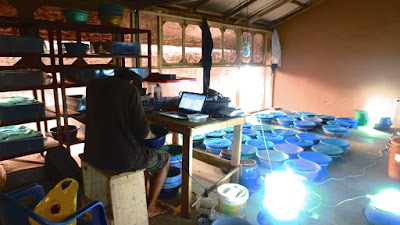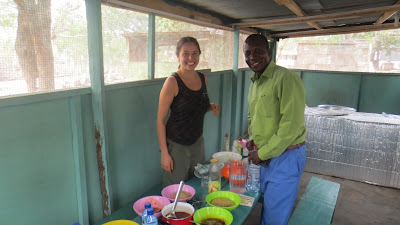Aquaculture in Africa is growing: from 55,690 tonnes in 2000 to almost 600,000 tonnes in 2010. Much of this growth is taking place in countries such as Ghana; and the vast majority of farmed fish in Africa are freshwater species, mainly the Nile tilapia and sharp-tooth catfish.
If we want to make a BSF by product that can be used in fish feed, we need to get a better understanding of the market and supply and demand. For this reason we identified and contacted 15 hatcheries and 2 broodstocks producers in the region to get their insight on the market and demand for feed:
10 « international » hatcheries
5 Ghanaian owned hatcheries
2 « outlier » hatcheries (i.e. : Kumasi, Winneba, Accra) + 1 outlier for the pilot testing
We were able to map the main actors in this part of the supply chain following this sampling frame:
1) Internet searchingThe first step was to looking for the biggest hatcheries and the list of registered companies on the net, for instance on Sarnissa's Website and on Ghana's directory (
http://www.ghanaweb.com/GhanaHomePage/telephone_directory/category.php?ID=58). We also reached contacts at the Water Research Institute and at the MOFA to obtain a list of hatcheries.
2) Publications searchingSeveral publications gave us a list of companies in Ghana with their phone numbers. We drew from past researches to build on our knowledge of hatchery and broodstock producers in the region.
3) Key informant interviewsa. Jacques Magnee (Ranaan - feed producer)
b. Mark amechi (Tropo)
c. Marc Towers (West-Africa Fishes)
d. Mr Lee (broodstock producer and very famous among Tilapia producers, for his high quality broodstock strains)
4) Pilot testing at Wild geckoWild Gecko is a newly settled hatchery (less than 6 months old). It was selected for the pilot testing because it produces very small quantities, and has started the company with ornamental fishes, and is an « outlayer » for the sampling frame, They gave us a lengthy overview of farming industry and their perception of the fish sector in Ghana.
We then polished the questionnaire we had drawn and added more questions.
5) Snowball samplingOnce the questionnaire was settled, we contacted all the hatcheries on the list and set meetings with them. Every time, we asked them to rank and define the hatcheries around them (and among Ghana as well).We got a list of 16 hatcheries. 13 are on the Volta. 1 is in Kumasi (Outlayer) 1 is in Winneba (Outlayer), 1 in Accra (Outlayer).
6) Going down the Volta riverTo be able to sharpen the sampling frame, we decided to use a boat going from Asetsuare to Ada (Volta estuary) to plot the remaining small hatcheries. From this we added 2 of them.
We asked them about the scale of their business, the type of feed they use, where they get it from and how many suppliers they have for it, and what they though about using BSF by-products in feed. We also took this chance to get their insight on the market as a whole, their experiences over the last 5 years and expectations for the next.
 |
| Testing the performance of our BSF feed on Tilapia Fish |
An interesting aspect of this was to ask producers if they have any use with their dead fishes. Mortality rates can be pretty high, according to one of our interviewee about 10% of the amount produced per day (reaching up to 300kg for the the biggest fish farms - not hatcheries - around the lake) and representing in some cases nearly 125 000 Dollars loses per month.
This could represent an opportunity to supply nutritious waste for our BSF; yet some farms have already found a use for their dead fishes. They sometimes supply the Kobi market: smoked and salted grow-out fishes which are typical in the region. At times they also use them to feed the catfish they also produce on a smaller scale.
Overall, producers had an interest in novel feed ingredients. As one of our interviewee stated however, "cash is king" so the product will have to be competitive with other feeds. Ranaan fish feed, the most popular one used here, costs about 65GHS per bag of 25kg at the retailer and 58GHS (45% protein - 15-20% fat).
 |
| Flosell farm, Volta Region |

















